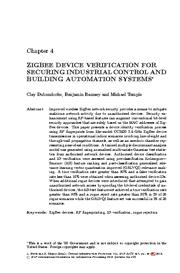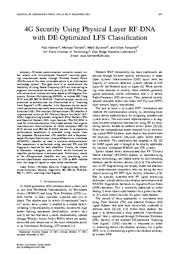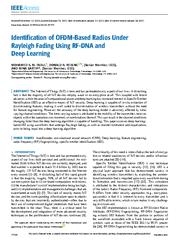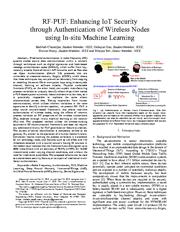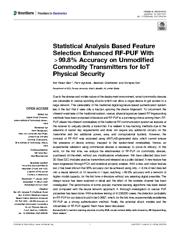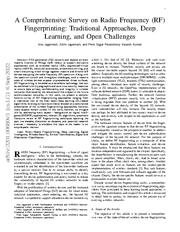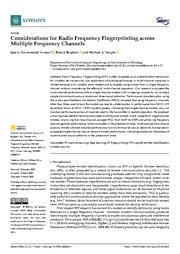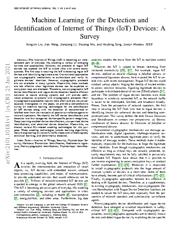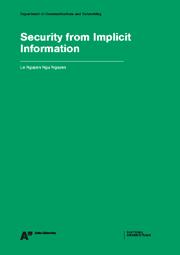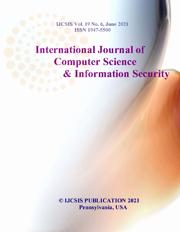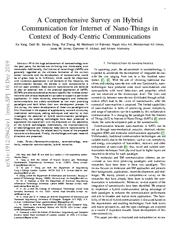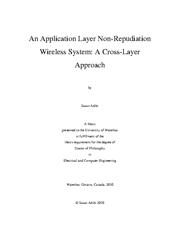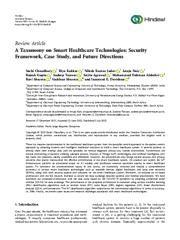A copy of this work was available on the public web and has been preserved in the Wayback Machine. The capture dates from 2018; you can also visit the original URL.
The file type is application/pdf.
Filters
ZigBee Device Verification for Securing Industrial Control and Building Automation Systems
[chapter]
2013
IFIP Advances in Information and Communication Technology
Security enhancement using RF-based features can augment conventional bit-level security approaches that are solely based on the MAC addresses of Zig-Bee devices. ...
This paper presents a device identity verification process using RF fingerprints from like-model CC2420 2.4 GHz ZigBee device transmissions in operational indoor scenarios involving line-of-sight and through-wall ...
Rogue devices can spoof bit-level credentials such as MAC addresses and network encryption keys. This has motivated research in physical layer (PHY) features that can uniquely identify network nodes. ...
doi:10.1007/978-3-642-45330-4_4
fatcat:exzvmti7cbdytittrcvs5eyeja
4G Security Using Physical Layer RF-DNA with DE-Optimized LFS Classification
2011
Journal of Communications
The goal here is to demonstrate the feasibility of using Radio Frequency (RF) air monitoring to augment conventional bit-level security at WAPs. ...
The resultant DE-optimized LFS classifier is implemented within an RF "Distinct Native Attribute" (RF-DNA) fingerprinting process using both Time Domain (TD) and Spectral Domain (SD) input features. ...
The goal is to provide additional Physical layer (PHY) based security at WAPs to augment existing bit-level mechanisms. ...
doi:10.4304/jcm.6.9.671-681
fatcat:fm5g3ofgjfcchkp5jlnfdtmlfi
Identification of OFDM-based Radios under Rayleigh Fading using RF-DNA and Deep Learning
2021
IEEE Access
INDEX TERMS AutoEncoder, convolutional neural network (CNN), Deep learning, feature engineering, radio frequency (RF) fingerprinting, specific emitter identification (SEI). ...
This coupled with recent advances within the areas of computational power and deep learning has increased interest in Specific Emitter Identification (SEI) as an effective means of IoT security. ...
RELATED WORK RF-DNA fingerprinting and similar SEI works augment wireless network security through the use of radio signal classification. ...
doi:10.1109/access.2021.3053491
fatcat:osacrvfskrdvzb5c3363f6pkka
Preprint: Using RF-DNA Fingerprints To Classify OFDM Transmitters Under Rayleigh Fading Conditions
[article]
2020
arXiv
pre-print
Previous research has suggested the use of Specific Emitter Identification (SEI), a physical layer technique, as a means of augmenting bit-level security mechanism such as encryption. ...
Additionally, this work presents classification results using RF-DNA fingerprints that were extracted from received signals that have undergone Rayleigh fading channel correction using Minimum Mean Squared ...
Wireless networks traditionally implement security mechanisms within the OSI model's higher layers (e.g., Data-link layer), which ignores the Physical (PHY) layer. ...
arXiv:2005.04184v1
fatcat:ifnvpb5jdjg6viujhbsbgjxvui
RF-PUF: Enhancing IoT Security through Authentication of Wireless Nodes using In-situ Machine Learning
[article]
2018
arXiv
pre-print
Traditional authentication in radio-frequency (RF) systems enable secure data communication within a network through techniques such as digital signatures and hash-based message authentication codes (HMAC ...
Physical unclonable functions (PUF), on the other hand, can exploit manufacturing process variations to uniquely identify silicon chips which makes a PUF-based system extremely robust and secure at low ...
Visualization of RF-PUF at a system level [8] a stand-alone physical-layer security feature, or for multi-factor authentication, in conjunction with network-layer, transportlayer and application-layer ...
arXiv:1805.01374v3
fatcat:dpwz6xo76zeq3ilpfo4yvbvzti
Statistical Analysis Based Feature Selection Enhanced RF-PUF With >99.8% Accuracy on Unmodified Commodity Transmitters for IoT Physical Security
2022
Frontiers in Electronics
To circumvent the inherent weakness of the traditional system, various physical signature-based RF fingerprinting methods have been proposed in literature and RF-PUF is a promising choice among them. ...
However, the concept of RF-PUF was proposed using MATLAB-generated data, which cannot ensure the presence of device entropy mapped to the system-level nonidealities. ...
., 2015) has used RF-DNA (Radio Frequency Distinct Native Attribute) dependent RF fingerprinting. RF-DNA uses various statistical features. ...
doi:10.3389/felec.2022.856284
fatcat:63fub7cslretlm4w2gj2a3yedy
A Comprehensive Survey on Radio Frequency (RF) Fingerprinting: Traditional Approaches, Deep Learning, and Open Challenges
[article]
2022
arXiv
pre-print
RF fingerprinting is heralded as a candidate technology that can be combined with cryptographic and zero-trust security measures to ensure data privacy, confidentiality, and integrity in wireless networks ...
Motivated by the relevance of this subject in the future communication networks, in this work, we present a comprehensive survey of RF fingerprinting approaches ranging from a traditional view to the most ...
The outputs of the neural networks are then combined using a two-level scorebased aggregation method. ...
arXiv:2201.00680v3
fatcat:435d72iv6zgi7f2exu2tynlcpm
Considerations, Advances, and Challenges Associated with the Use of Specific Emitter Identification in the Security of Internet of Things Deployments: A Survey
2023
Information
layer technique for securing Internet of Things (IoT) deployments. ...
The focus of this survey is a review of SEI publications from the perspective of its use as a practical, effective, and usable IoT security mechanism; thus, we use IoT requirements and constraints (e.g ...
, Native, Attributes (RF-DNA) fingerprint. ...
doi:10.3390/info14090479
fatcat:qgyn7zlby5b4fhuda25bgwi6mu
Considerations for Radio Frequency Fingerprinting across Multiple Frequency Channels
2022
Sensors
Radio Frequency Fingerprinting (RFF) is often proposed as an authentication mechanism for wireless device security, but application of existing techniques in multi-channel scenarios is limited because ...
Performance characterization using the multi-class Matthews Correlation Coefficient (MCC) revealed that using frequency channels other than those used to train the models can lead to a deterioration in ...
This is particularly useful for communications security applications where the reported bit-level identity (e.g., MAC Address, Serial Number) of a device cannot or should not be implicitly trusted. ...
doi:10.3390/s22062111
pmid:35336280
pmcid:PMC8955887
fatcat:mohx6mftxfdhfpwuifssmvhmx4
Machine Learning for the Detection and Identification of Internet of Things (IoT) Devices: A Survey
[article]
2021
arXiv
pre-print
The first step in securing the IoT is detecting rogue IoT devices and identifying legitimate ones. ...
Conventional approaches use cryptographic mechanisms to authenticate and verify legitimate devices' identities. However, cryptographic protocols are not available in many systems. ...
A brief dataflow of RF-DNA is given in Figure 9 . ...
arXiv:2101.10181v1
fatcat:in5x7tp5fbdernmlzyvv52muke
Learning with Vertically-Partitioned Data, Binary Feedback, and Random Parameter Update
2019
IEEE INFOCOM 2019 - IEEE Conference on Computer Communications Workshops (INFOCOM WKSHPS)
Figure 6 . 7 . 67 p n (n) = 1 πσ 2 e (n−μ) 2 −σ 2 ; p n (n) Acceleration sequence augmented with video noise level (N (μ v , σ 2 v )) (d) Acceleration sequence augmented with high noise level (N (2 · μ ...
Features can be learned from the data, for example using the penultimate layer of a neural network [15] . ...
An auto-encoder [156] is an unsupervised learning technique in which a feedforward non-recurrent neural network is trained to reproduce an input. ...
doi:10.1109/infcomw.2019.8845203
dblp:conf/infocom/NguyenS19
fatcat:cjgyjbtyhrejhdn37okuaq3nmi
Journal of Computer Science IJCSIS June 2021 Full Volume
2021
Zenodo
from computer science, mobile & wireless computing, networking and information security. ...
The International Journal of Computer Science and Information Security (IJCSIS) is one of the leading open access publisher, with hundreds of papers published each year related to different areas ranging ...
The function of IoT's devices cooperation in local and short range networks can also be used in this layer [18] . Network Layer The purpose of this layer allows data transmission and routing over the ...
doi:10.5281/zenodo.5556913
fatcat:yineojxcujg4jnvqt6i742dhii
A Comprehensive Survey on Hybrid Communication for Internet of Nano-Things in Context of Body-Centric Communications
[article]
2019
arXiv
pre-print
Afterwards, the related security issues of the proposed networks are discussed. Finally, the challenges and open research directions are presented. ...
In this survey, the recent developments of these two paradigms are first illustrated in the aspects of applications, network structures, modulation techniques, coding techniques and security to then investigate ...
To this end, the authors utilize the measured pathloss as the fingerprint of transmit nano device to do the authentication at the physical layer. ...
arXiv:1912.09424v1
fatcat:yuhsss5chrdgxlrzqwvfvxjypy
An application layer non-repudiation wireless system: A cross-layer approach
2010
2010 IEEE International Symposium on "A World of Wireless, Mobile and Multimedia Networks" (WoWMoM)
This thesis considers this issue in a wireless medium and studies the Quality of Service (QoS)/Security requirements in terms of network parameters and performance metrics. ...
This leads to a cross layer design, which considers various QoS and security parameters export and import to and from various layers with a special focus on the application layer. ...
QoS/Security Parameters at the Physical (PHY) Layer PHY layer deals with the actual transmission of bits and bytes on the physical medium (e.g., wire, air, etc.). ...
doi:10.1109/wowmom.2010.5534971
dblp:conf/wowmom/Adibi10
fatcat:tzhws7t5tzao7eh7qcxfn5srfy
A Taxonomy on Smart Healthcare Technologies: Security Framework, Case Study, and Future Directions
2022
Journal of Sensors
Moreover, we propose an AI-based architecture with the 6G network interface to secure the data exchange between patients and medical practitioners. ...
The performance of the proposed architecture is evaluated using various machine learning (ML) classification algorithms such as random forest (RF), naive Bayes (NB), logistic regression (LR), linear discriminant ...
The physical layer is responsible for radio frequency generation and selection, modulation of bits, signal detection, and bit-wise encryption. ...
doi:10.1155/2022/1863838
doaj:3a72a966893c4a73ae9a56e2a67195f0
fatcat:5lrdjsnj25dkbkx2jdtzbozi44
« Previous
Showing results 1 — 15 out of 128 results

